12 Steps to Designing Your Outdoor Kitchen
April 16th, 2025 | 15 min. read
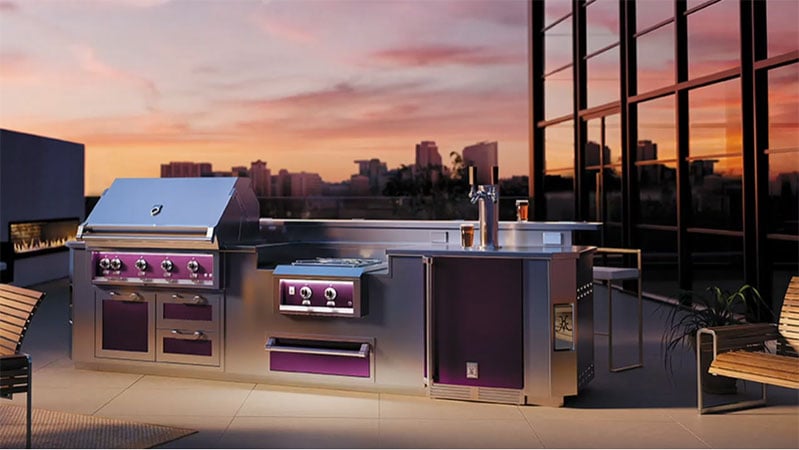
Designing an outdoor kitchen sounds easy... until it’s not.
Do you start with the grill? The layout?
What about weather, permits, or the 19 types of countertops everyone suddenly has an opinion on?
Whether you want to throw summer cookouts, add home value, or just stop dragging dinner outside, this guide covers 12 smart, battle-tested steps to get it done right.
You’ll hear from top industry experts.
You’ll know what matters and what’s not worth your time. Plus, we’ll show you how to avoid the painful (and pricey) mistakes we’ve seen too many people make.
But not you.
Let’s build the kind of setup that makes people say, “Wait, you actually use yours?”
In this guide, you’ll learn from:
- Ashley Smith, Director of Design at Urban Bonfire
- Basil Larkin, former VP of Sales at Hestan
- Russ Faulk, Chief Designer at Kalamazoo Outdoor Gourmet
- Scott Grugel, former President of Lynx Grills
We’ve also included helpful links along the way.
You’ve got this.
Let’s get inspired. (I know I was. This was a fun one to write.)
📌Skip Ahead:
- Plan Your Space
- Choose Your Team
- Prep for Weather
- Fuel, Power, & Water
- Lighting
- Ventilation
- Pick a Grill
- Add Cooking Options
- UL-Rated Appliances
- Design the Layout
- Chalk It Off
- Select Materials
- Prefab vs. Custom
- Key Takeaways
- FAQs
12 Steps to Designing Your Outdoor Kitchen
Step 1: Define Your Outdoor Kitchen Goals

How do you plan to use this space?
Is it just for burgers and hot dogs?
If so, a simple grill setup with some room for prep may be more your speed.
Or are you envisioning a fully functional outdoor kitchen?
If it’s going to be a central hangout spot, you might need more countertop space for entertaining, prepping, or even for your kids to do homework outside.
Keep in mind: outdoor cooking tools and serving trays are usually bigger than indoor ones.
So, you’ll likely need more counter space than you have in your regular kitchen.
It’s one of the most overlooked parts of outdoor kitchen design, and one of the most important when you’re cooking and serving guests.
In your indoor kitchen, you plate everything individually. Outside, you’ll probably serve on large platters instead.
Also, not every kitchen layout works for every backyard. Some setups may not be the best- or safest - option for your space.
Browse photos and layout plans for inspiration, but don’t copy them blindly. Use them as references, not blueprints.
While I was writing this, my kid jumped in and made a few outdoor kitchens in Midjourney. One’s a treehouse. The other looks like it belongs at Hogwarts.
I added them below because why not?
They’re a good reminder that designing your space should be fun... and a little imagination never hurts.
Treehouse-Inspired Outdoor Kitchen
.jpg?width=1000&height=563&name=Outdoor-Kitchen-Design-Made-Easy-A-Step-by-Step-Plan-to-Build-Your-Dream-Outdoor-Kitchen--(1).jpg)
(Designed by my kid in Midjourney. Definitely not to code, but full of heart.)
Harry Potter-Inspired Outdoor Kitchen

(Complete with wizardly vibes and zero building permits.)
Step one is inspiration. Look at plans, sketches, inspirational images, and/or create a Pinterest board, and do not limit yourself by only looking at other outdoor kitchens! Find inspiration from indoor kitchens and create a wish list as well as a list of "must-have" items you would like to include."
- Ashley Smith, Urban Bonfire
Step 2: Who Plans and Builds Your Outdoor Kitchen?

Now it’s time to figure out who’s actually going to design and build your outdoor kitchen.
Should you hire an architect? A landscaper? A contractor, builder, or mason?
And how involved should your cabinet shop or appliance store be?
The answer could be any of the above. Any of those professionals could take the lead, or you could buy a ready-made island and take the DIY route.
One of the biggest mistakes people make is not clearly defining who is responsible for what. That’s where most problems begin.
Start by researching contractors and suppliers in your area. Check their portfolios, read reviews, and vet them thoroughly before handing over the reins.
Don’t assume every builder knows how to design an outdoor kitchen.
In places like Miami, FL, outdoor kitchens are common and integrated into the home.
In Boston, they’re a newer trend, so experience can vary.
Always check past work, and look for reviews on Google, Yelp, or the Better Business Bureau.
Step 3: Cooking in the Elements - Wind and Rain

When I spoke with grill experts, one thing came up again and again: weather matters.
You’ll want to block direct sun and protect yourself from rain, but don’t forget about the wind.
I hadn’t thought about it at first either, but wind can blow smoke straight into your house if you're not careful.
"Understand prevailing winds. You don't want the smoke from your grill or smoker blowing into your house."
- Scott Grugel, Middleby Residential Sales
You may also want to build a cover or partial structure over the cooking area to keep yourself dry.
Just remember: if you’re adding a structure, you’ll need proper ventilation (we’ll cover that in Step 6).
Step 4: Fuel Types
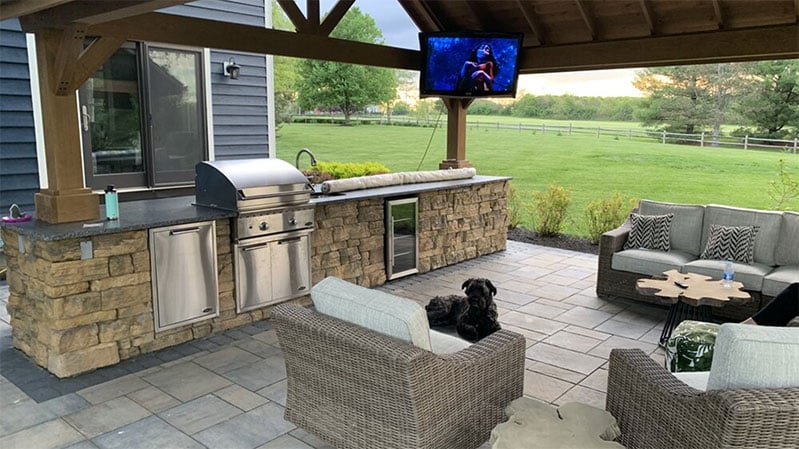
If you're using a natural gas grill or side burner, you’ll need to have gas lines plumbed to those locations.
If that’s not an option, you can always use a propane-powered grill instead.
Just keep in mind: natural gas is more convenient since you won’t have to keep refilling tanks.
You'll also need to plan for electricity.
Most outdoor kitchens require power for things like grill ignition systems, blenders, rotisserie motors, and even phone charging.
Electricity is also essential for refrigerators, warming drawers, and wine coolers.
And don’t forget water lines if you want an ice maker, sink, faucet, or even an outdoor dishwasher.
One important note: If you live in a region with freezing winters, anything with water will need to be properly winterized to avoid damage.
Step 5: Lighting

Photo courtesy of The Designery
Lighting should be part of your outdoor kitchen plan, especially for grilling at night.
Maybe it’s because I used to sell lighting at Yale, but I really understand how important it is.
Most people assume their existing outdoor lights will be enough.
But those lights are usually too bright, poorly placed, and not focused where you need them - like over the grill.
You want to see what you’re cooking without relying on a portable lamp.
On a powerful grill, it can take just 30 seconds to go from medium to rare.
One great idea? Add lighting to your railings.
You should also include task lighting near your grill so you’re not guessing what’s done and what’s not.
Personally, I’m a huge fan of lighting tape. It’s just strips of LEDs on translucent tape.
They’re easy to install and work great for accent lighting almost anywhere.
Step 6: Ventilation (If Needed)
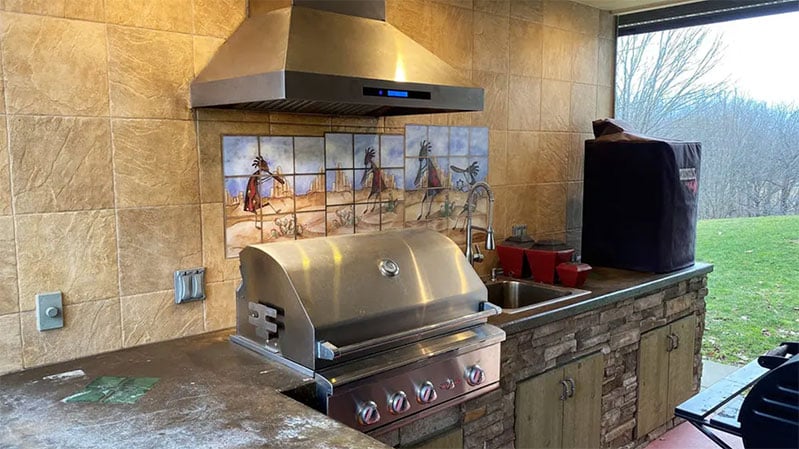
Long-time readers of this blog know I’m particular about venting an outdoor grill - and for good reason.
It’s difficult to capture the vast amount of smoke a BBQ grill produces.
That’s why many people leave their grills completely exposed to the open air.
If your layout allows for it, that’s often the best option with no venting required.
Of course, open setups leave you exposed to the weather, which isn’t always ideal.
If your grill is going inside a three-season porch or any enclosed space, proper ventilation is essential.
I’ve seen too many outdoor kitchen photos on Houzz that look great but show clear signs of smoke damage. A good design should work in real life, not just in pictures.
Gas grills produce a surprising amount of smoke, grease, and fumes. That includes formaldehyde, carbon dioxide, carbon monoxide, and nitrous oxide.
To vent properly, you’ll need a deep hood and a powerful blower.
(Not like the underpowered setups I often see, where the hood looks nice but can’t handle the grill.)
The smoke needs to be captured effectively, directed into the hood, and exhausted with enough force to keep the air clean. You need both parts to work together.
I suggest leaving your grill fully open to the outdoors, so you don’t have to worry about ventilation.
But if your grill isn’t completely outside, spend time planning your ventilation system. If you grill often, it might be worth investing in a commercial-grade setup.
Here’s what I recommend:
- A hood that is at least 27 inches deep and 18 inches high
- A blower with 1,500 CFM or more, depending on how often and what you cook
🔍Read More: How to Vent an Outdoor Grill
Step 7: Choosing the Best BBQ Grill

There is an endless array of BBQ grills. You’ll find models from brands like Hestan, DCS, Kalamazoo, Weber, Lynx, and many others.
Your grill is the cornerstone of your outdoor kitchen. It’s the center of your cooking flow. Everything else should be arranged around it.
"Configuring your outdoor kitchen appliances starts with the grill. Your grill is the centerpiece of the outdoor kitchen."
- Russ Faulk, Kalamazoo Outdoor Gourmet
Think of it like this: in your indoor kitchen, the sink is typically central because it’s used most often, followed by the stove and then the dishwasher.
Outside, the grill takes that central role for the same reason.
Now take a moment and ask yourself:
- How do you like to grill?
- Do you prefer speed—or slow smoking over time?
- Are you looking for added flavor and texture?
- What’s your go-to grilling method?
Your answers will help determine the type of grill that’s right for you. You may even find that more than one type fits your style.
Types of Grills
Here’s a breakdown of the most popular grill types including what they do well, where they fall short, and what to know before buying.
Even if brands market themselves as all-in-one solutions, there’s no perfect grill for every situation.
Gas Grills
.jpg?width=799&height=450&name=LiveAbode-Features-Hestan-Outdoor-Built-In-Grills%20(1).jpg)
Gas grills are fast, easy to use, and excellent for searing (even more so if they include an infrared sear zone).
Pros:
- Incredibly fast heat-up time
- Great searing capability
- Simple to operate
Cons:
- Gas grills don’t naturally add flavor or texture to food like other fuel types.
Notable Option:
Kalamazoo’s hybrid gas grill stands out. It features a drawer that lets you burn wood or charcoal for extra flavor. Price starts around $20,000, so it’s not for everyone.
Pellet Smokers

Pellet smokers are among the most popular types of smokers. They excel at adding flavor and texture with a variety of pellet options.
Pros:
- Deep, smoky flavor and texture
- Many include smart tech like Wi-Fi and programmable timers
Cons:
- Best for low-and-slow cooking
- Max temperatures usually range from 400–500°F
- Can’t sear effectively
- Not ideal for quick grilling (don’t rely on a pellet grill as your only grill)
Charcoal

Charcoal grills give you the speed of gas with the flavor of a smoker.
Pros:
- Great mix of speed and flavor
- Used by pros with wood or charcoal in competitions
Cons:
- Requires refilling charcoal after each use
- Must empty ash regularly
- Less consistent temperature than gas
- Fewer flavor combinations compared to pellets
Ceramic
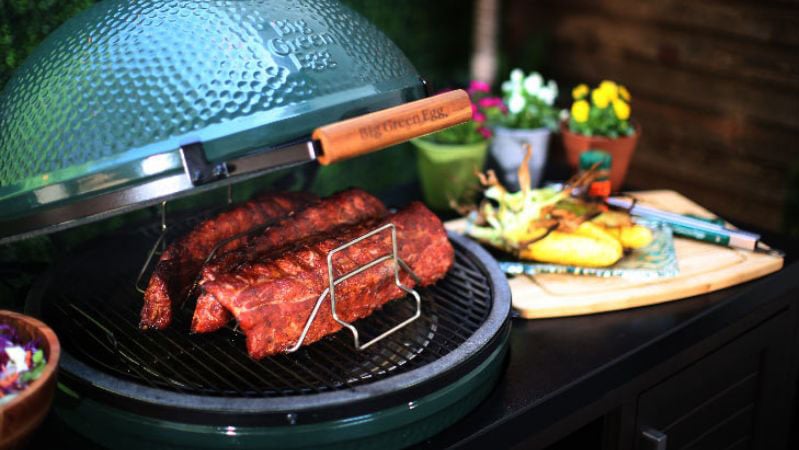
Ceramic grills (e.g., Big Green Egg, Kamado Joe) are versatile and capable of doing a bit of everything.
Pros:
- Excellent temperature control (Kamado Joe in particular)
- Can smoke, grill, roast, and even bake
Cons:
- Learning curve involved
- Like charcoal, they require hands-on attention
Top BBQ Grill Brands for Your Outdoor Kitchen
Let’s break down the best options by category. You’ll find the right fit for how you cook and what you want to spend.
Luxury Grills
Many top grill brands, like Hestan, DCS, and Lynx, have similar power and features. But the small details matter.
Kalamazoo

Kalamazoo is a hybrid grill that runs on professional-grade burners. It uses charcoal and/or wood to deliver speed, texture, and flavor.
It also features one of the deepest cooking surfaces on the market, allowing for more thorough natural convection cooking.
Kalamazoo grills, pizza ovens, and accessories are the most expensive, but they’re widely considered the best in the world.
Lynx
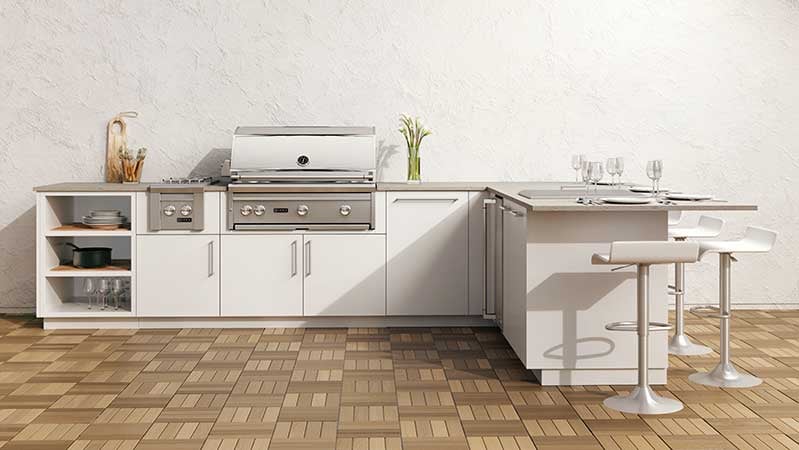
Lynx grills are professional-grade and known for their high heat output.
Their ceramic burners are built to withstand harsh weather conditions, ensuring long-term, consistent performance.
You can purchase a Lynx in several configurations, including models with all gas burners, all infrared, or a combination of both.
💡Pro Tip: Infrared is a direct source of heat, while gas spreads the flame. Infrared will cook faster. Just be careful not to burn your food.
Hestan
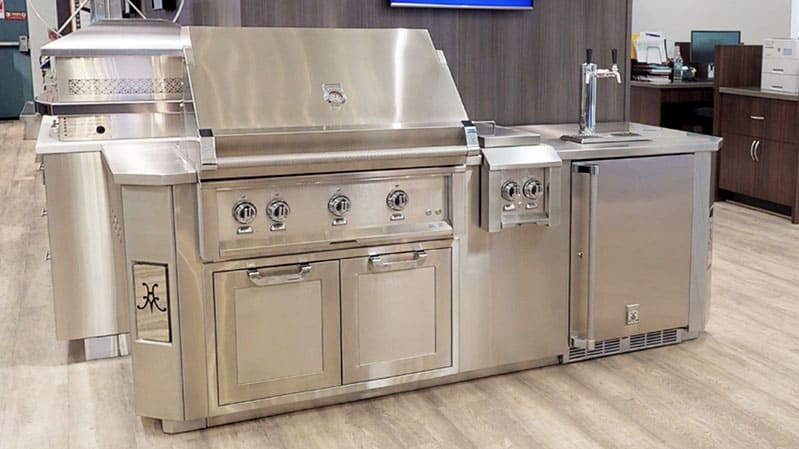
Hestan Residential is a premium line created by commercial powerhouse Meyer.
They stand out with laser-cut grates that help maintain a consistent sear.
Their Trellis burner provides an even temperature across the entire grilling surface.
Hestan also offers grills in a wide range of colors - something no other manufacturer does.
🔍Read More: Best Professional Outdoor BBQ Grills
Mid-Range Grills
Strong performance and reliability at a more approachable price point. Great for everyday grilling enthusiasts.
DCS
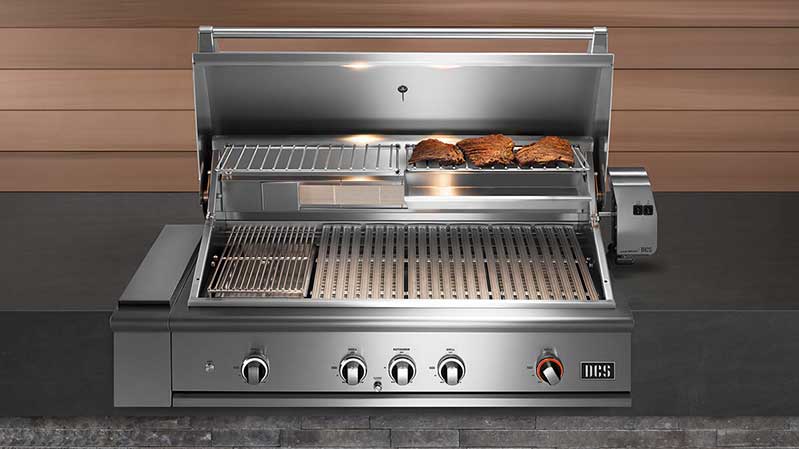
DCS was the first professional grill brand to offer multiple series.
Today, they include a charcoal accessory and powerful burners rated at 25,000 BTUs each.
DCS uses ceramic rods to intensify heat and replicate the effect of a sear burner - without actually needing one.
Weber

If DCS was the first professional grill brand, Weber was the first to make reliable grills more affordable.
They may not offer the high-output burners of premium brands, but their Genesis and Spirit series deliver strong performance at a much lower price.
Weber also makes smart grills that integrate tech for easier cooking.
Specialty Grills & Accessories
Perfect for flavor lovers, food experimenters, or those looking for alternatives to traditional grilling.
Kamado Joe

Kamado Joe offers some of the best temperature control of any ceramic grill. They’re fun to cook with and extremely versatile. You can grill, smoke, roast, or bake.
Just know there’s a learning curve, especially if you’re new to ceramic grilling.
Traeger Pellet Smokers
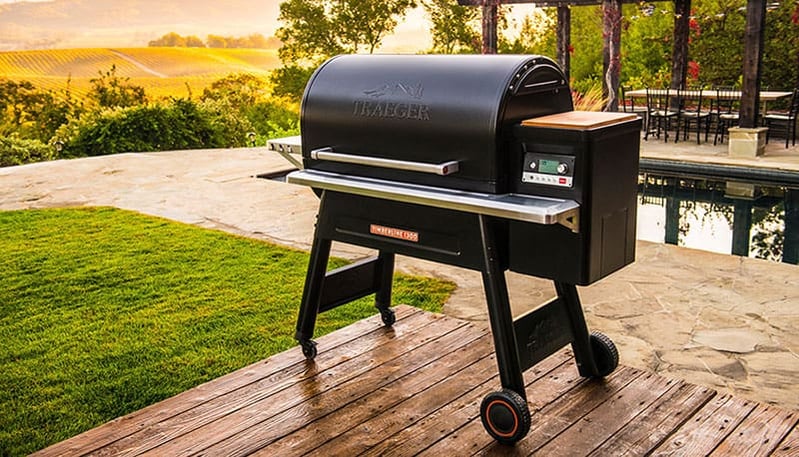
Traeger inspires strong opinions - some love it, others not so much.
It’s excellent for smoking, but not ideal for grilling.
What it does offer is a ton of flavor customization through a variety of wood pellets.
Outdoor Griddles
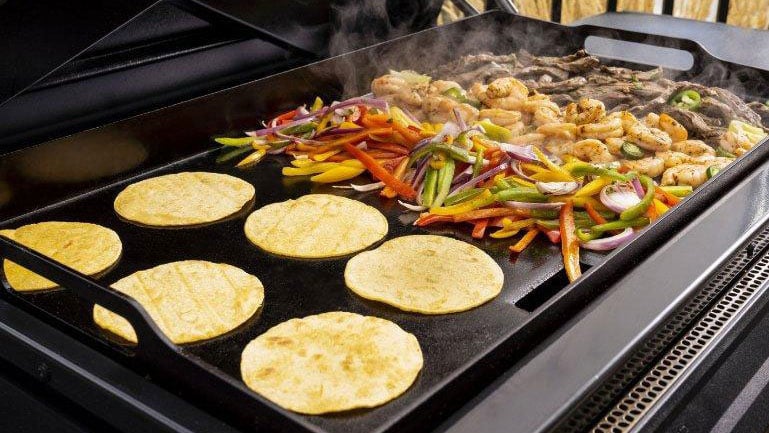
Griddles are a great option for cooking outside beyond traditional grilling.
Brands like Blackstone, Traeger, and Weber all make reliable outdoor griddles that are perfect for breakfast, burgers, stir-fries, and more.
🔍Read More: The Best BBQ Grills, Griddles, and Smokers
Step 8: Cooking Options

Think of your outdoor kitchen as an extension of your indoor one.
Even though it’s often one of the last features added to a home, it’s smart to start thinking about it while planning your indoor kitchen layout.
All outdoor appliances should be UL-rated for outdoor use. Look for durable materials that resist rust and hold up to the elements.
As you plan, consider how your indoor and outdoor appliances can complement each other. You don’t need to duplicate everything, but your setups should work together.
Design Around How You Cook
Not every outdoor kitchen needs every appliance, but here are a few worth considering based on how you like to cook.
"This might include incorporating a pizza-making station or adding in a power burner to cook lobster. You do not need to limit yourself to a "traditional" kitchen. Make it suit your needs and your space." Ashley Smith, Urban Bonfire
Secondary Appliances and Cooking Accessories
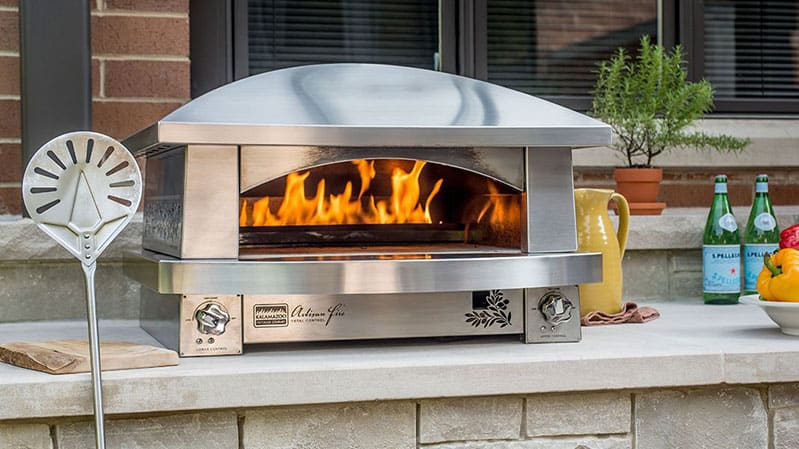
You don’t need to buy everything we mention in this guide. If you’re not going to use a smoker, don’t buy one.
If your grill is close to your indoor kitchen, you don’t need much else.
But if your setup is farther away, you might want to add more features - like extra storage or a side burner - to avoid running back and forth.
Here are a few extras that can take your outdoor cooking setup to the next level:
- Pizza Ovens: These can be pricey, but most models cook pizza fast—and they do it well.
- Warming Drawers: Install one near or under your grill to keep food warm and moist for up to 3 hours. Perfect for long days of entertaining.
- Asado Cooktops (Griddles): These large, flat cooktops are incredibly versatile. If you’ve ever had sausages and peppers at a ballgame, they were likely cooked on one. You can cook almost anything on a griddle—breakfast, stir-fry, smash burgers, you name it.
- Side Burners: Great for boiling lobsters or corn on the cob. A side burner lets you prep sauces, sides, or full meals without stepping away from the grill.
Refrigeration
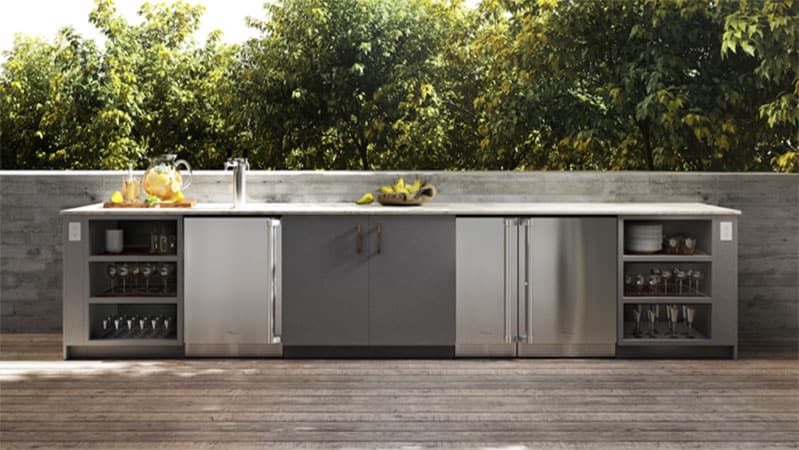
There’s a wide range of refrigeration options available for your outdoor kitchen.
From compact fridges to wine coolers and ice makers, you’ll find plenty of choices depending on your needs and budget.
If you’re installing an ice maker or dishwasher, you’ll need a cold water line.
Maintenance is always critical, especially with ice makers. Be sure to clean them regularly to keep them running smoothly and avoid build-up.
Storage
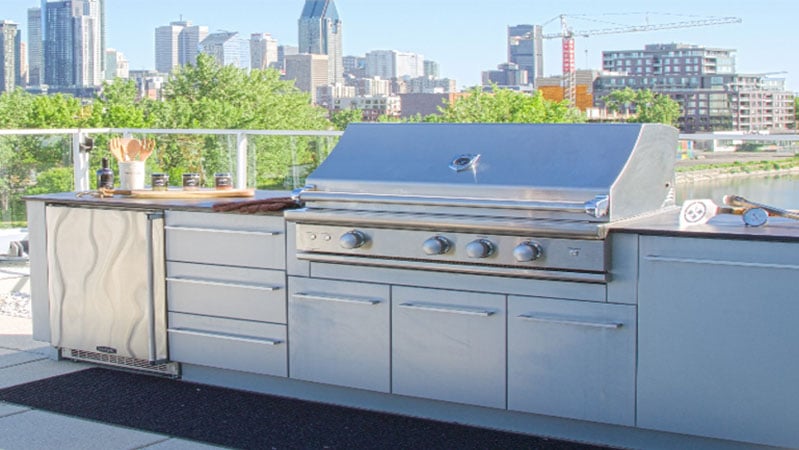
Every outdoor kitchen needs some form of storage or cabinetry.
You can purchase cabinets from manufacturers like Lynx, Kalamazoo, Challenger, or Urban Bonfire, among others.
They’re also available in many prefabricated kitchen packages (we’ll cover those later in the guide).
Sinks and Faucets
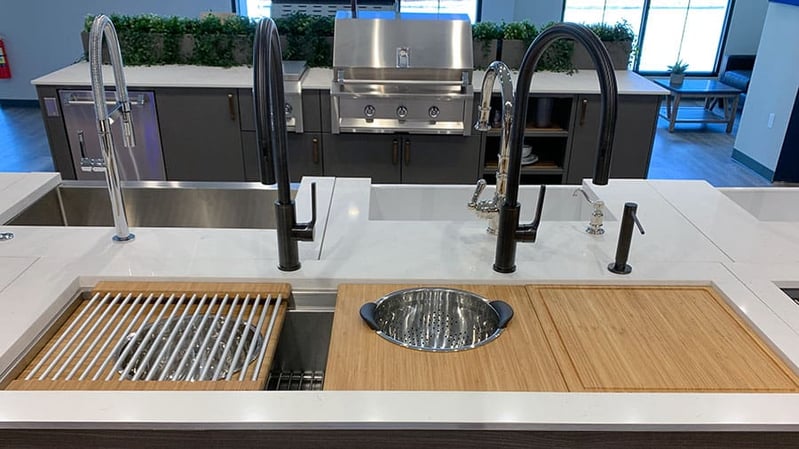
If your outdoor kitchen is located far from your main indoor kitchen, adding a sink and faucet is a smart move.
One standout option is The Galley. It’s a marine-grade sink that ranges in size from 2 to 7 feet and can double as a prep station or workspace.
Step 9: Appliances (UL Rated for Damp Location)

Any appliance placed in your outdoor kitchen should be UL-rated for outdoor use - specifically for damp locations.
These appliances are built with durable materials, often with more metal components, and are designed to resist rust and handle exposure to the elements.
"Location of the kitchen is usually the next best step. You'll want to pay attention to things like direct sunlight (do you need coverage) and wind direction (location of the grill)."
- Basil Larkin, Hestan Commercial Corporation
Step 10: Choosing the Best Outdoor Kitchen Layout
As I have said, the grill is your centerpiece.
That said, you’ll want to apply the same planning logic you would for your indoor kitchen.
- Burners and other cooking appliances should be grouped together for efficiency.
- Refrigeration isn’t essential to the cooking process, so it doesn’t need to be placed nearby.
- The sink is one of the most-used appliances for washing, cleaning, and prep. If you're including a sink, make it central to your layout.
You have four types of outside kitchen layouts:
- Island
- L Shape
- U Shape
- Galley
Island Outdoor Kitchen Layout
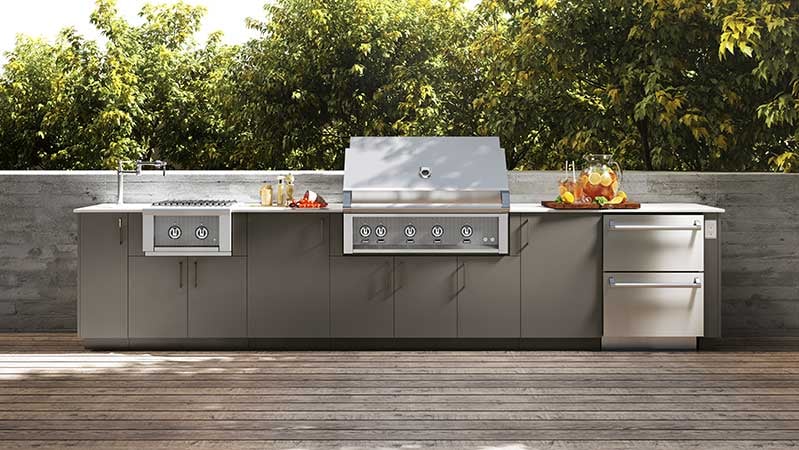
The most popular island has a grill in the center and serving appliances on either side.
Although you must serve and eat elsewhere, the island setup is one of the most space-efficient options.
💡Pro tip: If you include a faucet next to the burner, you won’t have to carry a heavy pot of water from inside, you can fill it right there.
L-Shape Outdoor Kitchen Layout
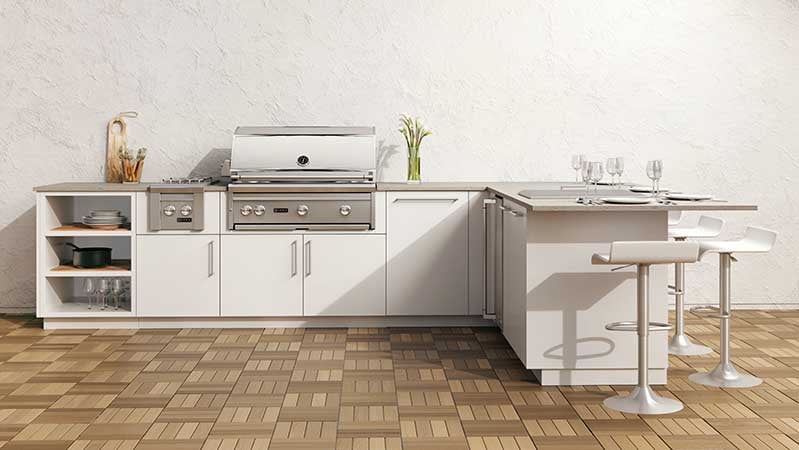
You can serve food easily in an L-shape layout. Many designers raise the counter slightly to make serving more convenient. The L-shape is efficient and practical.
Note the distance between the grill and the seating in the image above. It’s easy to serve from here.
"If you like to entertain, consider adding an island as a place for people to sit and gather around so that the cook can interact with guests, or creating an L shape to incorporate seating."
- Ashley Smith, Urban Bonfire
U-Shape Outdoor Kitchen Layout
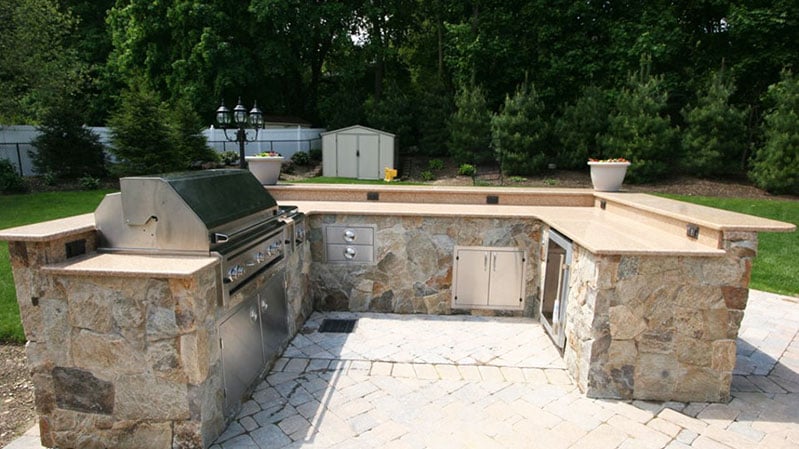
U-shaped outdoor kitchens are typically larger, allowing for more space to entertain and serve.
You can also incorporate more appliances on the other side of the layout.
Galley Outdoor Kitchen Layout
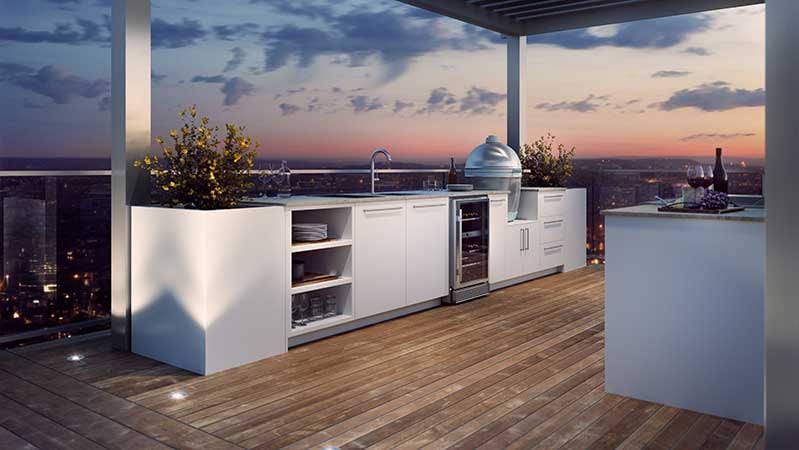
Like many indoor setups, a galley layout separates the cooking zone from the serving and eating area.
This layout is becoming increasingly popular for outdoor entertaining.
Step 11: Chalk It Off
Once you’ve selected everything, chalk out the diagram in your current space to see if it looks right to you and test out the flow.
That's right; walk around the space as if you are grilling and entertaining.
Step 12: Choose the Best Materials for Your Outdoor Kitchen
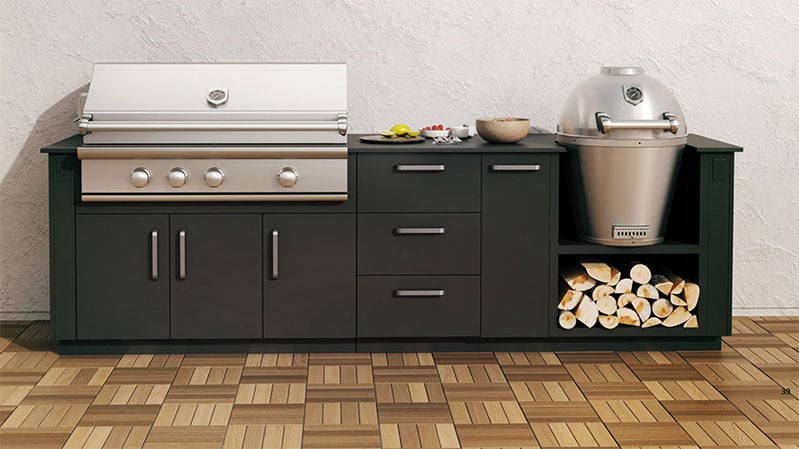
You want your outdoor kitchen to be weather-resistant, especially in climates like New England.
For countertops, choose non-porous materials such as granite, Dekton, concrete, or stainless steel.
- Tile can crack.
- Granite needs occasional sealing.
- Dekton and other modern surfaces offer low-maintenance alternatives and are growing in popularity.
Urban Bonfire, an outdoor cabinet and design company, recommends Dekton for its durability and ease of care.
Avoid quartz and limestone. They weather poorly and aren’t UV stable, meaning they’ll fade over time.
For cabinetry, the best materials include:
- Marine-grade aluminum
- Stainless steel
- Marine-grade polymers
- Stone
Companies like Urban Bonfire and Challenger Designs offer prefab units made from powder-coated aluminum.
If you prefer wood, teak is your best option for outdoor use. That said, marine-grade aluminum is generally the most durable.
Keep in mind: there’s no universal definition of “marine grade.”
It typically refers to 304 or 316 stainless steel with high molybdenum content or materials treated with taurine to resist corrosion.
Even with weather-resistant materials, you’ll still need to wipe everything down regularly to maintain your kitchen.
Prebuilt vs. Custom Outdoor Kitchens
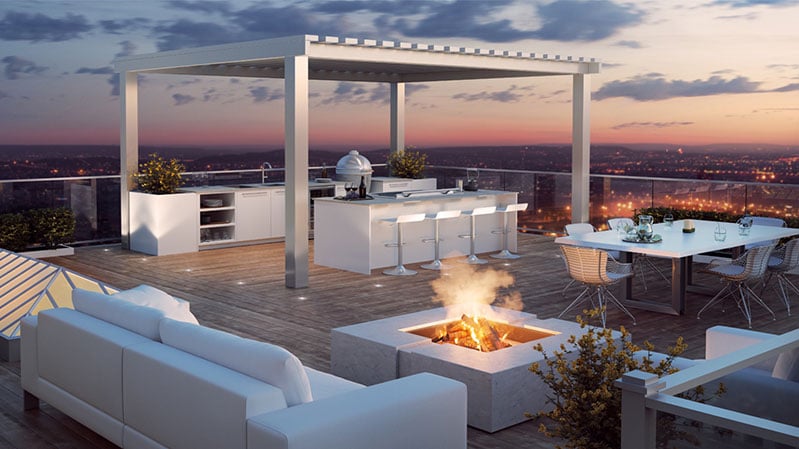
Custom Outdoor Kitchens
If you want full control over the layout and finishes, you can work with an architect, designer, or builder.
This is a good option if you have the time, space, and money for a custom setup.
But it usually costs more and takes longer to build. You’ll also need to coordinate different people for the job.
Prebuilt Outdoor Kitchens
Prebuilt kitchens are quicker and more affordable.
Many brands (like Lynx, Kalamazoo, DCS, and Hestan) offer ready-made cabinet sets.
Two popular options are:
1. Urban Bonfire (Montreal-based)

- Uses thick, weather-safe aluminum with a powder-coated finish that holds up in sun, snow, and saltwater.
- Works with most grill brands. Some models ship in just 2 to 4 weeks. Prices start around $7,000.
2. Challenger Designs (Coastal Series)

- Made from powder-coated aluminum with a built-in Blaze grill. The top is easy to clean and won’t rust.
- Models start under $5,000.
Both are easy to set up and can be taken with you if you move.
Final Takeaways
It all starts with who will be helping you. Make sure they’re qualified and experienced.
Then it’s about you and your space. Start by thinking through your entertaining style and how you plan to use the kitchen.
Centralize your grill, then choose your appliances, cooking accessories, storage, and refrigeration.
Once your plan is set, walk it off or sketch it out in your actual space.
If you're building from scratch, plan your electrical and plumbing early - these are critical and easy to overlook.
Also, don’t rule out prefab or modular solutions. In many cases, they can help you avoid delays and stay on budget.
Just make sure to read reviews and confirm the materials are built to handle your local weather.
Today, you can customize your outdoor kitchen with virtually any grill, appliance, or accessory you want.
Just plan thoughtfully, so you can enjoy it fully later.
FAQs
Answers to the most commonly asked questions about designing an outdoor kitchen.
What are the essential appliances for an outdoor kitchen?
At a minimum? A good built-in grill, a side burner (so you're not running in for boiling water), and a refrigerator for drinks and marinating magic. Upgrade with a sink, warming drawer, or even a pizza oven.
How do I plan the layout of my outdoor kitchen?
Think like a chef—your layout should follow a flow: cold zone (fridge), prep zone (counter space/sink), hot zone (grill, burners), and serving zone (bar or dining area).
What materials are best for outdoor kitchen cabinets and countertops?
Go for weatherproof and low maintenance. Stainless steel, marine-grade polymer, and teak are top cabinet choices. For countertops, granite and concrete hold up well—just seal them so they don’t age.
Do outdoor kitchens need to be covered or under a roof?
Technically, no. But if you're in New England or anywhere with wild weather, a pergola, awning, or full roof keeps the party going rain or shine.
Can you install an outdoor kitchen on a deck?
Yes, but check your deck’s weight limits. Built-ins and stone can get heavy. You’ll also need fireproof insulation around the grill, because no one wants to light up more than the charcoal.
How much does it cost to build an outdoor kitchen?
Anywhere from $5,000 to $30,000+, depending on size, appliances, and finishes. The grill alone can be $2K to $10K. Want a beer tap, TV, and chef’s counter? It depends on what you want.
What type of grill is best for an outdoor kitchen?
Built-in gas grills are the most popular, but hybrids (gas + charcoal) are gaining steam. If you’re a wood-fired purist, go pellet or kamado-style. Just make sure the grill fits your cooking style and your cut-out dimensions.
Do I need a permit for an outdoor kitchen?
Often, yes, especially if you’re running gas, electric, or water. Local codes vary, so check before digging trenches.
How do I keep my outdoor kitchen appliances from rusting?
Buy outdoor-rated appliances and cover them when not in use. Look for 304 stainless steel.
What’s the best way to add lighting to my outdoor kitchen?
Layered lighting is key—task lighting over your grill and counters, ambient lights for dining, and accent lighting for the vibe. Just don’t blind your guests like they’re in an interrogation room.
Additional Resources
Hey, what separates the amateurs from the pros in the grilling world? Knowledge. And our BBQ Grills Buying Guide is packed with it.
We're talking insider insights on brands like Lynx, Hestan, DCS, and Kalamazoo.
Plus, we break down grill types - gas, pro-gas, ceramic, pellet, charcoal - and show you how to design an entertainment area that wows.
Over 1 million readers have already leaped. Ready to join them? Download the guide now and see the difference it makes.
Related Articles:
- The Ultimate Guide to Designing Your Dream Outdoor Kitchen
- Differences Between Charcoal, Gas, Professional Gas, and Pellet Grills
- 6 Mistakes to Avoid When Buying an Outdoor Gas BBQ Grill
- Best Professional Outdoor BBQ Grills
- What's the Difference Between Weber Spirit, Genesis, and Summit Series Grills?
Why Should You Trust Us?
It seems that every appliance review has nothing but glowing comments about almost every product, yet you read customer reviews and they are almost universally bad.
We are here to fill in the disconnect. We'll give you the best features, and the drawbacks as well, including reliability based on over 37,000 calls performed by our service team just last year. Our goal is to give you ALL the information so you know what's right for you.
Please consider subscribing or adding to the conversation in the comments below. We appreciate you stopping by.
Steve Sheinkopf is the third-generation CEO of Yale Appliance and a lifelong Bostonian. He has over 38 years of experience in the appliance industry, and he is a trusted source of information for consumers on how to buy and repair appliances.
Steve has also been featured in numerous publications, including the
New York Times,
Consumer Reports,
The Boston Globe,
Bloomberg Radio, the
New York Post,
The Wall Street Journal, and
Entrepreneur, for his knowledge of how to buy appliances and appliance repair.
Steve is passionate about helping consumers find the best appliances for their needs, and he is always happy to answer questions and provide advice. He is a valuable resource for consumers who are looking for information on appliance buying, repair, and maintenance.
Despite being the worst goalie in history, Steve is a fan of the Bruins and college hockey, loves to read, and is a Peloton biker. The love of his life is his daughter, Sophie.
A Note About Pricing
Pricing on this blog is for reference only and may include time sensitive rebates. We make every attempt to provide accurate pricing at time of publishing. Please call the stores for most accurate price.




